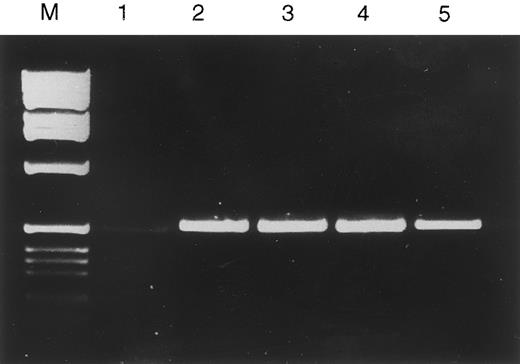To the Editor:
We read with interest that a second thrombin receptor, designated protease activated receptor 3 (PAR3), has been cloned from human and mouse tissues.1 The human and mouse PAR3 cDNAs were cloned by screening a human small intestinal cDNA library and a mouse spleen cDNA library, respectively. The investigators have shown the presence of PAR3 mRNA in a range of human and mouse tissues including bone marrow, by Western blot analysis, and they have demonstrated the occurrence of PAR3-specific mRNA in mouse megakaryocytes by in situ hybridization. However, the investigators do not provide any direct evidence for expression of this novel thrombin receptor in human platelets or megakaryocytes.
By using reverse-transcription polymerase chain reaction (RT-PCR) and PCR-based library screening strategies we have successfully cloned and sequenced PAR3 cDNA from human platelets and from a number of human erythroleukemic (HEL, K562) and promonocytic (U937, HL60) cell cDNA libraries.
Whole blood was collected from healthy human volunteers by antecubital venepuncture into acid citrate dextrose (final concentration, 11 mmol/L) and platelets purified by density centrifugation (Nycodenz; Sigma-Aldrich Co Ltd, Poole, UK). Platelet RNA was extracted by a caesium chloride step gradient method.2 Platelet cDNA was synthesized from 1 μg of total RNA using oligo (dT)15 primed reverse transcription in a total volume of 25 μL (200 U M-MLV RT; 25 U rRNasin ribonuclease inhibitor; 2 mmol/L dNTPs; 50 mmol/L Tris-HCl, pH 8.3; 75 mmol/L KCl; 3 mmol/L MgCl2 ; 10 mmol/L DTT; Promega). Aliquots of platelet, HEL, K562, U937, and HL60 cDNA were taken for PCR amplification of PAR3 cDNA using primers, as follows: forward TTCCTCACCTGCATCAG; reverse ACTGGGTCGAAGCAACTATT (1.25 U Taq DNA polymerase; 0.2 mmol/L dNTPs; 1.5 mmol/L MgCl2 ; 20 mmol/L Tris-HCl, pH 8.4; 50 mmol/L KCl; Promega Ltd, Southampton, UK). Cycling parameters were as follows: 3 minutes at 94°C; followed by 35 cycles of 45 seconds at 94°C, 30 seconds at 55°C, 60 seconds at 72°C, and finally a 10-minute extension step at 72°C. After thermocycling, 5 μL of each 50-μL RT-PCR or PCR mixture was electrophoresed on a 1.5% agarose gel containing 10 μg/mL ethidium bromide and visualized under UV transillumination (Fig 1). A single 521-bp product was amplified by both RT-PCR from platelet total RNA and by PCR from the four cDNA libraries. Platelet RT-PCR, HEL cell PCR, and K562 cell PCR fragments were subcloned into pCRII.1 (Invitrogen BV, NV Leek, The Netherlands) and sequenced on both strands (Vistra Thermosequenase; Amersham International plc, Little Chalfont, UK). Sequences obtained were compared to those held in Genbank and EMBL using the GCG program BLAST, which returned 100% sequence identity with human PAR3.
Agarose gel electrophoresis of platelet RT-PCR and cDNA library PCR fragments. Lane M, molecular-weight markers (1-kb ladder; GIBCO-BRL, Life Technologies Ltd, Paisley, UK); lanes 1 through 5 show a single 521-bp product amplified from the following sources. Lane 1, platelet cDNA; lane 2, HEL cell cDNA library; lane 3, K562 cDNA library; lane 4, U937 cDNA library; lane 5, HL60 cDNA library.
Agarose gel electrophoresis of platelet RT-PCR and cDNA library PCR fragments. Lane M, molecular-weight markers (1-kb ladder; GIBCO-BRL, Life Technologies Ltd, Paisley, UK); lanes 1 through 5 show a single 521-bp product amplified from the following sources. Lane 1, platelet cDNA; lane 2, HEL cell cDNA library; lane 3, K562 cDNA library; lane 4, U937 cDNA library; lane 5, HL60 cDNA library.
These results provide evidence for the expression of a second thrombin receptor on human platelets and on a number of erythroleukemic and promonocytic cell lines, suggesting that PAR3 is not only found on platelets and megakaryocytes but also on cells of the monocytic lineage. Whether PAR3 acts as a functional thrombin receptor on these cell types remains to be shown.
From searches of Genbank and EMBL sequence databases, a number of other sequences were found to share approximately 45% homology with PAR3, such as PAR1, PAR2 and the P2Y1, P2Y4 and P2Y8 purinoceptors. The original aim of these cloning experiments was to identify the platelet P2T purinoceptor by amplifying P2Y purinoceptor-like sequences that may be present in a platelet mRNA population. The degenerate oligonucleotide primers used were designed from conserved regions within the putative third and seventh transmembrane domains P2Y1 and P2Y2. The degree of sequence homology with the P2Y1 purinoceptor suggests that these receptor famillies may be closely related and it would be interesting to see whether this novel proteinase receptor can also be activated by purines or their synthetic analogues.
ACKNOWLEDGMENT
Supported by a Wellcome Trust Clinical Veterinary Research Training Scholarship.
All cDNA libraries used were synthesized from oligodT primed cDNA and nondirectionally cloned into the vector pCDM8 (Invitrogen). We thank Prof Janet Allen for the HEL cell cDNA library, and the UK Human Genome Mapping Project for providing the K562, U937, and HL60 cDNA libraries.


This feature is available to Subscribers Only
Sign In or Create an Account Close Modal